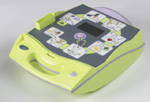Easy-to-use defibrillator a CPR life saver
by Heather MurphyPublic Relations
The latest addition to the MUSC clinical team is a small neon-green box.
 With
the ZOLL AED Plus biphasic defibrillator, anyone with CPR training on campus
or in the hospital can administer lifesaving techniques accompanied by
an electrical current.
With
the ZOLL AED Plus biphasic defibrillator, anyone with CPR training on campus
or in the hospital can administer lifesaving techniques accompanied by
an electrical current.
“It’s like having a CPR coach inside,” said Amy Berckman, Hospital and Territory manager for ZOLL Medical Corporation. “It’s really neat that MUSC is doing this. It's the first facility in Charleston County and one of the first teaching hospitals in the South to implement these devices.”
The AED Plus can directly interpret what’s going on with someone’s heart, rather than the person having to understand exactly what the blips on one of the old defibrillator screens means. Now a person does not need to have advanced cardiac life support training to operate a defibrillator.
The new device includes a computer-generated voice, graphics of each step and shows when to initiate the shock.
Last week was the official rollout for the AEDs, with about 100 of them placed throughout MUSC, including Rutledge Tower, Institute of Psychiatry and Hollings Cancer Center.
These devices are considered revolutionary because they take an unlikely approach, based on the idea that less is more.
According to the article “Demystifying Biphasic Defibrillation” by registered nurses Elaine Amato-Vealey, Ph.D., and Patricia Colonies, hospital trials show that low energy shocks from the biphasic machine are more effective than high energy shocks by monophasic machines.
The biphasic machine still uses two electrodes like the monophasic but instead of sending just one current from one electrode to another, it sends a reverse current as well. Also, the biphasic model uses a different waveform technology, either a biphasic truncated exponential (BTE) or a rectilinear biphasic wave.
The result is a machine with decreased incidences of skin burns and myocardial dysfunction.
“This will be the safest place in the event of a cardiac arrest not only for the patients, but for visitors that are just walking through. In theory, at under $2,000 each, AEDs should be as common as (public telephones),” said Berckman.
The AED also enables more staff beyond those with advanced cardiac life-support training to stabilize in an emergency situation.
Registered nurse John Hudson, head of the mayday response team, said, “It’s good because it’s new technology and it will replace a lot of 12- to -13-year-old machines. It’s also going to make the hospital more consistent since we’ll have only two types of machines instead of four or five.”
The move towards a paddle-free environment comes at about the same time as some other changes for the mayday team. According to Hudson, next month will bring some changes to the “code cart,” which contains items needed in a cardiac emergency.
The changes will include the drug box on top of the cart and more dividers
in the drawers to help nurses and staff become more easily acquainted with
the carts.